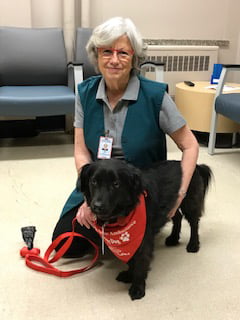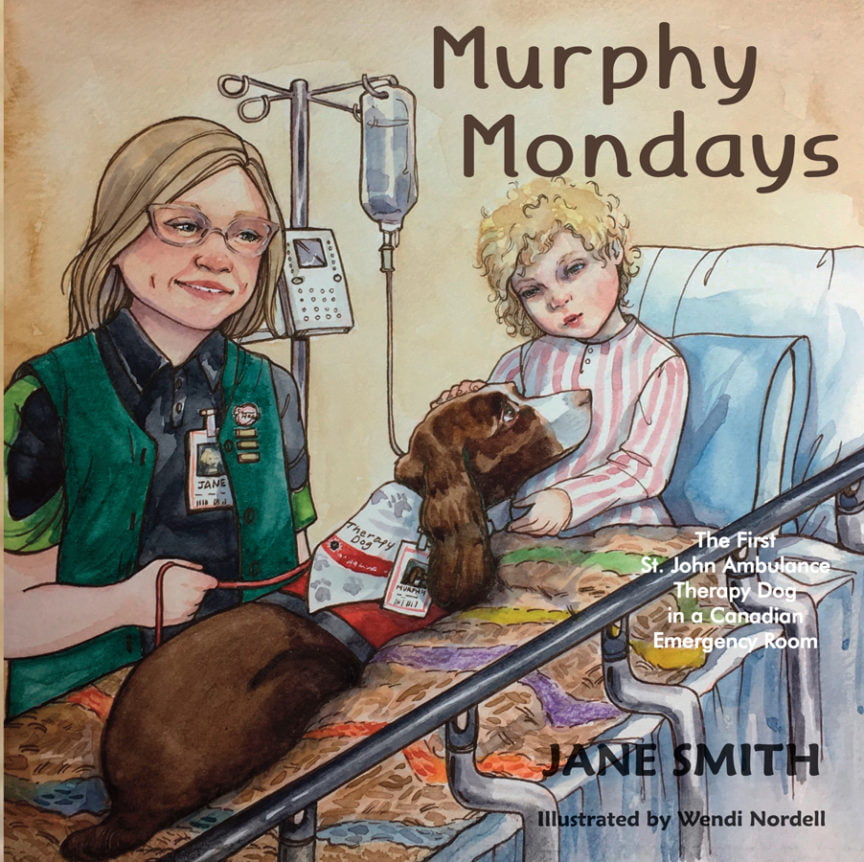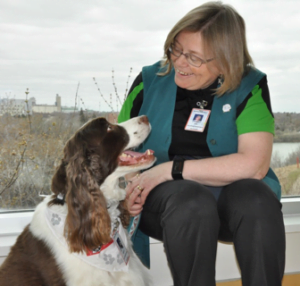Nearly every Monday for the past 3 years the Royal University Hospital Emergency Department (ED) has been graced by the presence of Murphy and his handler, Jane Smith. A St. John Ambulance (SJA) Therapy Dog Team and part of the Royal University Hospital (RUH) Volunteer Pet Visitation Team, Jane and Murphy were the first SJA Therapy Dog Team that we are aware of working in the emergency department setting in a Canadian hospital. As part of their mission to bring pet visitation to ED’s across the country and around the world, they recently published a children’s book, Murphy Mondays.
This post will summarize the ED pet therapy program through the lens of the physicians, researchers, dog-therapist teams, and patients who have been impacted by it. The book about the project (Murphy Mondays) can be purchased from Driver Works, Chapters, McNally Robinson, or directly from Jane Smith for $13.99 with proceeds going to the RUH Emergency Department (via the RUH Foundation) and the Saskatchewan SJA Therapy Dog Program.
Therapy dogs in the emergency department… really!?
Yes, really! Dr. James Stempien is the Interim Provincial Head of Emergency Medicine in Saskatchewan and was one of the advocates for getting the program started. He faced some resistance in doing so, noting that the first responses he received were responded to with a brief statement: “There is no need for a meeting, you will not be doing this.” However, Dr. Stempien and his team persisted to convince everyone of the therapy dogs’ value for patients and the ED as a whole.
When asked about the impetus for the program, he acknowledged that the ED isn’t a wonderful place for our patients. It is loud and scary. The patients are there because they have nowhere else to go for help. He believes that having the dogs in the ED is a significant gesture that demonstrates the staff care – they want their patients to be as comfortable as possible. This is in keeping with the goal of the Therapy Dog Program to provide love and support to those whose lives can be improved by the therapeutic benefits of contact with animals.
Beyond the patients, Dr. Stempien believes that the staff benefits from the therapy dogs. The ED is a stressful place to work and the staff regularly have traumatic experiences. Seeing the staff light up as one of the dog walks in the door demonstrates the value of the program. Notably, since hearing about this program emergency departments in Charlottetown, Mount Sinai, Thunder Bay, and Calgary have adopted or considered similar programs.
Who are these therapy dogs and what sort of training do they have?
While everyone agrees that your dog is adorable, they may or may not be a suitable therapy dog. The testing and screening – for both the dog and their handler – is extensive.
Gail Kuhn, the Director of Community Services at St. John Ambulance, explains that handlers make up an essential element of the dog-handler team so they certify both the handler and the dog. The handler component is important both to ensure that they can oversee and guide their dog, but also to take advantage of the one-on-one discussions with patients that the dog can facilitate.
The standards for the program were developed nationally and are given to handler-dog pairs. The training includes stress testing that is conducted a lot like an Observed Structured Clinical Experience (OSCE) and used to determine how they will react in various stressful situations (e.g. stationary crowd, milling crowd, distractions, non-responsive people, etc). Additional testing and experience are required to work with children. There is no restriction on the breeds of the dogs (although they do have to be >1 year old) but both the dogs and their handlers must be physically able to do the job.
After the dog-handler teams receive their certificates from SJA they are brought on board at RUH by Laurie Korol, the Manager of the RUH Volunteer Workforce and vetted through the same process as any other volunteer.

Pictured are some of the SJA Therapy Dog Teams involved with the RUH pet visitation program. Jeannette Halpape & Almond, Kimberly Davy & Payton, Justin Morrison & Jet, Dr. Colleen Dell & Subie, & Erika Quiring & Bruno
What does the evidence show regarding therapy dogs?
Not content to leave the value of therapy dogs in the ED to anecdote, the team at Royal University Hospital has actively participated in research investigating its value led by Dr. Colleen Dell (PhD). She notes that there is extensive evidence on the benefits of interactions with a pet on health. In the context of pets, one study found that they improve health in four ways: building social capital (a sense of belonging), harm reduction (people with pets use fewer substances because they want to be able to take care of their dog), behavior change (better exercise and healthier eating patterns by remembering the need to feed the dog), and participation in treatment plans improves (secondary to physiologic changes related to the hormones after interacting with dogs).1 Physiological responses are consistent with relaxation and include reducing heart rates, respiratory rates, and increasing positive hormones in the body.2
There is less research on the impact of therapy dogs in an environment like the ED. The team’s first study followed Jane Smith and Murphy for a year, surveying patients after they saw the therapy dog to determine how they were doing before and after the visit. This work is currently undergoing peer review.
What do the handlers say about their interactions?

Kimberly and Payton began volunteering in August of 2017. Every Tuesday evening they head to the ED together. She describes the ABC’s of a pet therapy as Acceptance (as staff and patients see the dogs and embrace it), Brightness (as peoples faces light up seeing a dog in the hospital), and Connectedness (as those who meet the dog bond and speak with the handler).

Ann and Chalky take direction from ED staff to visit the staff, patients, and families who are receptive to it. She is frequently able to use presence of the dog to get patients to initiate conversations that are not about their illness.
What do the patients say about their interactions?
Logan is a patient advocate who works with the therapy dog research team in the ED and has been a patient there many times. His memories of his time in hospital are foggy, but most of the ones that stand out involve the therapy dog teams. He believes that the dogs allow a respite from often overwhelmingly negative thoughts. At times when he hadn’t smiled for days, it was a dog that got him to smile again. He believes that he made it through, in part due to the impact of their visits.
Conclusion
If you have any questions or would like to be put in touch with any of the people mentioned above, please send us a message or leave a comment below. Please also consider supporting this program, the SJA Therapy Dog Program, and the RUH Emergency Department by purchasing ‘Murphy Mondays’ from Driver Works, Chapters, McNally Robinson, or directly from Jane Smith.
Post Uploaded by Amy Chung



